

极度干燥——关于刘建华的艺术
冯博一
“1342ºC”是烧制陶瓷时的最高窑温。以“1342ºC”作为刘建华最新个展的题目和对应OCAT深圳馆艺术家个案研究系列,意味着他的这次展览作品以“陶瓷”为媒介的规定性,而陶瓷材质和窑变的不确定特点,恰好可以比附刘建华多年利用陶瓷进行不断艺术实验的“熔点”过程和结果,也涉及到他在中国当代艺术生态中一个视觉“燃点”的活跃程度,包括从陶瓷烧制的技术手段、方法到作品的具体形态,从媒材利用到视觉语言实验,从展览空间到陈列方式等等。由此构成了刘建华这次个展在探寻传统与当代、物质与视觉文化之间关系的一种内在逻辑和多维的呈现。
在中国传统文化里,金木水火土中的“土与火”是构成物质世界的基本元素,也是看待物质世界的一种文化符号和象征。陶瓷作为“土与火”的具体物质材料,始终与刘建华的生存、成长与创作经历息息相关。刘建华将陶瓷作为物质的一种元素纳入到的他的艺术创作中,是他一直以来对陶瓷媒介的敏感、觉知和驾轻就熟的把握。刘建华近年来的创作,其中一个主要系列作品具有比较明显的观念和视觉的转向,并具体体现在他的这次个展之中。这些作品早已摆脱了艳俗艺术的夸张与反讽,也没有延续他以往写实主义和社会学考察的表现手法。
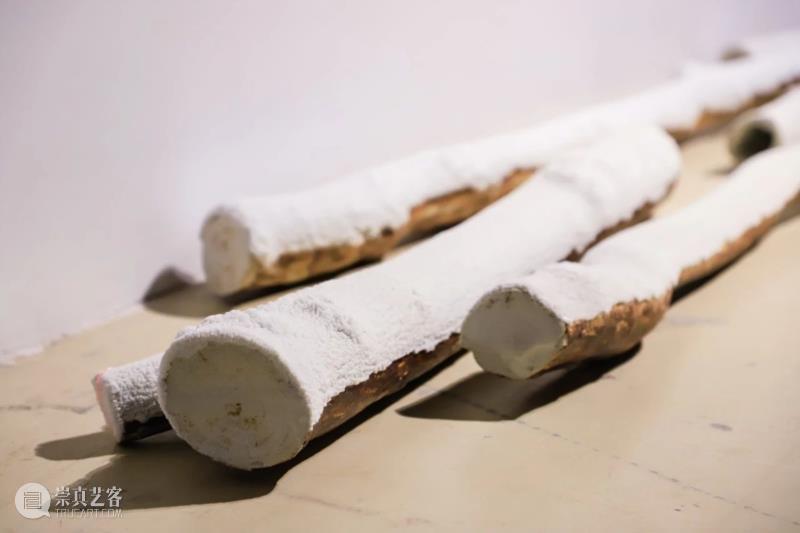

看似没有明确的现实文化针对性,而是将传统陶瓷形制的器物,例如《容器》《盈》,以及与我们日常生活密切相关的《白纸》《绳子》《2012年末》,尤其是自然之物,如《落叶》《雾凇》《沙》等作品,通过陶瓷不断实验烧制的技术,转化为一种逼真的日常生活或自然界中器与物的原生态,真实且自然地将简单、质朴的细节糅合在一起,而钟情于器物本身的材料属性和魅力。就作品的主题结构而言,绝非宏大叙事,也并非我们普通社会生活之外的东西,似乎是很随意地给予塑造,而没有留下所谓文化指向的痕迹,甚至会给观者造成一种错觉,以为艺术家的工作是毫无作为的,只是在享受着被陶瓷转换后的质感和手工翻制、塑造所带来的意外与惊喜。其实不然,这些作品中,刘建华并不刻意追求陶瓷器物的釉面表象,也避免了陷入个人化的趣味。从艺术表现方面来说,看似不经意的地方,其实是用了力的,只是给人一种返璞归真、浑然天成的感觉。王晓松说:“刘建华艺术的一个重要来源是对日常生活的体验,他用大家都熟悉的材料对生活中的寻常之物进行‘脱胎换骨’,在陌生的空间中创造特别的‘无意义’。”(见《不舍皮相:刘建华的2008-2018》第64 页,王晓松编著。上海三联书店2019年3月第1版)在我看来,这种具有复制、重构的转化方式,既改变了陶瓷作为物质的功能和性质,也超越了传统陶艺的单一样式,而成为记录自然、时间和记忆痕迹的一种标识,甚至直接对应和测度着自然与生态的沧桑变化。如他在景德镇陶瓷厂学徒时将陶泥反复摔打而成为《颜色》的堆积和汇集的斑斓形态,或许这反而构成了他创作的作品在视觉上的朴素、纯粹和极度干燥的内在力量。

有形的物品在刘建华的这些作品中,被无形的东西渐变为他不露声色的洞察与表现力度。换句话说,刘建华没有把对时间、空间的表现限制在记录的层面上,他也不满足于把媒介转换为一种简单的视觉形象,而是他把对自然、生活的态度和感受沉淀为“物品”的底色,超然物外地透过时光的浮尘去发现、思考我们习以为常的现实处境。因此,他是非常真实地表现了现实状态下的内心世界,可谓是一种在内心折射的抽象表现。
然而,不刻意寻求事物和现象的意义不等于事物和现象没有意义。根植于自然、日常之中的艺术,首先是在最无意义的事物中去发现有意义的东西的能力,一种将随便什么或随处出现的东西提升到重要位置上的能力。刘建华的《沙》《落叶》《绳子》等作品的复制过程,基本上消泯了我们惯常对雕塑艺术概念的理解与判断,或通过陶瓷媒材改变了原本之物的属性,而尽量地仿真,使作品产生出原本与摹本转换后的质感差异,更像是一种摹本的手迹。这当然不是进行普通意义上的拷贝,而是具有后现代主义方法的移植与挪用。


确切地说,刘建华以艺术的转化方式来展示他对传统、对陶瓷的不确定性和多重意义的思考与认知,并由此使得人工之物和自然之物距离感消失。所谓距离感产生美的传统美学观在他的这些具有后现代的艺术作品中不再拥有价值和意义,也牵涉到原创性、独一无二性的终极价值的消失,造成原有的本真性也失去了价值的判断。同时,如果说刘建华的创作是使用了后现代主义的方法,那么,他这种处理方式的目的在于,试图消除表层与深层、真实与非真实、能指与所指之间的对立关系的阐释模式,使价值的“深度”只在平面上产生,而深度的消失,则使传统探究深度的思维定式被打破、被抹平。自然与日常题材经过艺术家的选择和加工后有所升华,但这种处理不是要把意义强加在物品身上,而是要使之体现在人与物的具体生活情境的关系之中。也许,意义或价值就是从这种最不起眼、最中性的超日常的间隔中产生和获得,如同观众走在刘建华的《遗弃》作品里,倾听着陶瓷碎片在脚下发出的脆弱之声,也使观者获得的是一种介于自然的真实与非具体之间界限的关系,并在这种间离当中,相对充分地寻求到人与物的新诠释和超日常的体悟。
这就给当下的艺术创作提出了新的要求。因为,我们以往太注重艺术的针对性、作品的符号性,好像只有明确的现实隐喻与象征、批判与揭露才是艺术家、作品与观众进行交流的唯一基础和前提。而在刘建华的这些作品里,他是以低物质的视角,通过陶瓷复杂的工艺烧制来直面并呈现日常“物质”的自然状态,如《骨头》《白纸》;他是从传统文化资源和个人创作经验中,抽离或剪裁物质的碎片去释怀他对人文生态的关照情怀,如《容器》《2012年末》;甚至对陶瓷材质和视觉语言的青睐替代了物件本身的兴趣,如《迹象》《线条》等等。

这是在“互为塑造”的关系上对原有物表现方式的颠覆与拆解。我一直以为,在当代艺术的创作领域,对当代社会和文化的敏感将导致旧有观念的改变,而对材料与媒介的敏感将导致作品语言方式及形态的变异。因此,刘建华的这种实验,一方面提供了多元的创作意识来重新认识我们的日常经验,重新认识我们的现实与自然的生活;另一方面在物质内部处理物质,用物质本身的能量破坏它们的控制力,从而改变了以往自然属性的作用方向,揭示了已被接受的视觉模式的局限性,而对物质单一形态进行解构。使这些耳熟能详的物质所提供的标准变得短暂而不可靠,也在熟悉与陌生的交汇点上,体会出更耐人寻味的感知。刘建华说:“我想表现的并不是一个现实的场景,而是通过自然的常态、我们熟悉的现象来让人们去思考跟生命和时间以及个人情感的很多方面的一个感受。大家在看到落叶的时候既熟悉,又有一种陌生感。熟悉是因为落叶的这种形式,陌生感是因为它展览的方式,在美术馆、在不同的空间里面的展示,它提醒人们去感受很多不同的体验。”(同上,第250页)
如果从我们所处的时代背景考察刘建华创作的形态转向,这既是他对以往创作直接投射“现实”的可能性反思,并导致了他对艺术表现题材的复杂性再认识,具有艺术与现实复杂想象关系的重置;同时,也是关注现实生活的具体性,致使一种自然的物质和日常生活的特色开始呈现出来。这在中国经济崛起的时代强调日常生活的意义的背景下才成为可能,从而在现代性宏伟叙事中被忽略和被压抑的自然状态变成了艺术表现的主要关注点之一,并赋予了不同寻常的价值和意义。这种对自然与日常生活的再发现,以及通过对自然物象的摹写,将日常生活的琐碎细节和消费的价值被凸显出来,自然生命的历史和个体生命的书写被赋予了越来越大的意义。这并非是传统人文主义式宏大“主体”的展开,而是一种个人生存经验对物质形态的表达,这种经验不是一种对于现实的彻底反抗,而是在同自然世界的辩证关系中获取。刘建华表现的不仅是一种“物化”的情结,而是具有了具体的可量度的空间,即以一种非政治化的、普遍风尚和习俗的形式将个人发展、即时满足、追逐变化等特定价值观念,合理化为个人日常生活中的自由选择。因此,尽管他不是直接地表现现实的复杂,这也许反而成就了他的创作:隐逸于喧嚣的现实使他的艺术保留了寓情的细末微节,凸现了他视觉语言的质感与神秘——我们在观看他的作品时常常会遭遇到这样的细末微节。当然,这也和新的资本逻辑从实物经济的“物化”转向了虚拟经济的所谓“新经济”的抽象和虚拟的“物化”时代有关。但其实质则折射了获得宽泛概念的“物质”满足与快乐之后,恰恰是丧失了自然生存的安全感,以及焦虑、纠结等虚空的感受,如同他的《遗弃》所设置的废墟现场一般。所以,刘建华这次展览的作品,从某种程度上动摇了有关艺术创作的许多宏伟想象,也因此,更纯粹或“极度干燥”的语境成为他艺术创作的基本态度与立场。
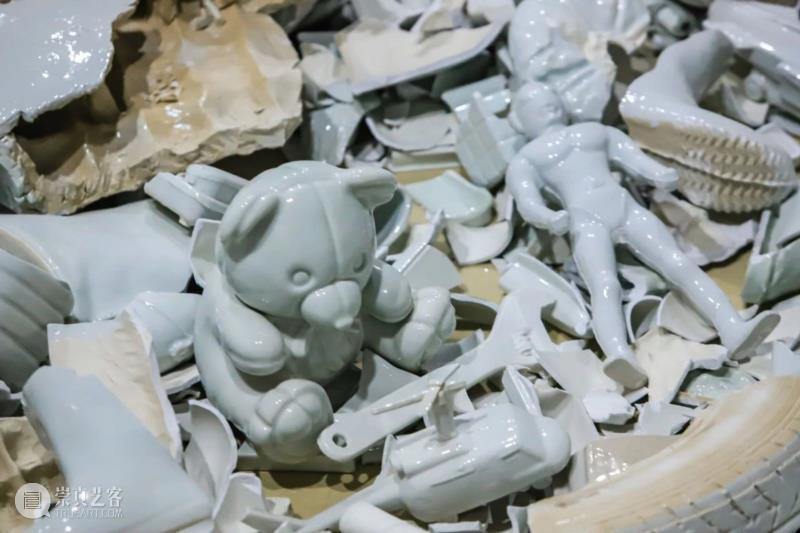
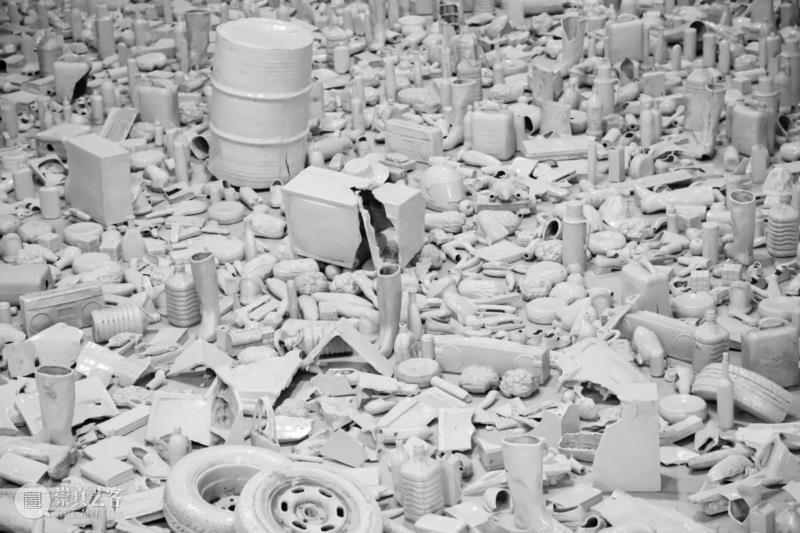
当然,这是我对刘建华新作中对低物质概念的一种理解及其与现实逻辑关系的阐释,抑或也是一种将寻常化的低物质的提升与反诘,以及带来的对自然、对日常生活的一种再发现。因此,刘建华的艺术实验不是将雕塑、装置等类别自身语言和风格的不断提升和丰富化,而是对艺术表达、媒介、视觉语言方式等边界问题的不断思考,注重于对传统陶瓷艺术、乃至现存艺术系统的重新定义,所希望达到的是对传统文化资源,在表达方式、审美趣味之间的相互打破,甚至对未来艺术创作的前瞻性影响。正如巫鸿所说:“刘建华艺术探索的一个本质性意义,就在于他把当代艺术与中国传统文化的接触点——或称为激活点——延伸到狭义艺术之外的视觉文化和物质文化领域,由此引入了技术性、物质性、视觉性等诸多理论问题,甚至可以引起对当代艺术定义进行重新思考。”(见巫鸿《陶瓷何以当代?——刘建华的艺术探索及引起的思考》一文,同上,第2页)。所以,刘建华的这种来自于传统内、外部的实验,不仅是对某一传统类别与样式的审美或语言的完美化,也带有不断实验、挑战和颠覆的突破作用,甚至构成他在当代艺术系统中个人的,抑或中国经验的一种视觉样本。如同他《盈》作品的充溢和把《白纸》有意地翘起一个卷边一样。

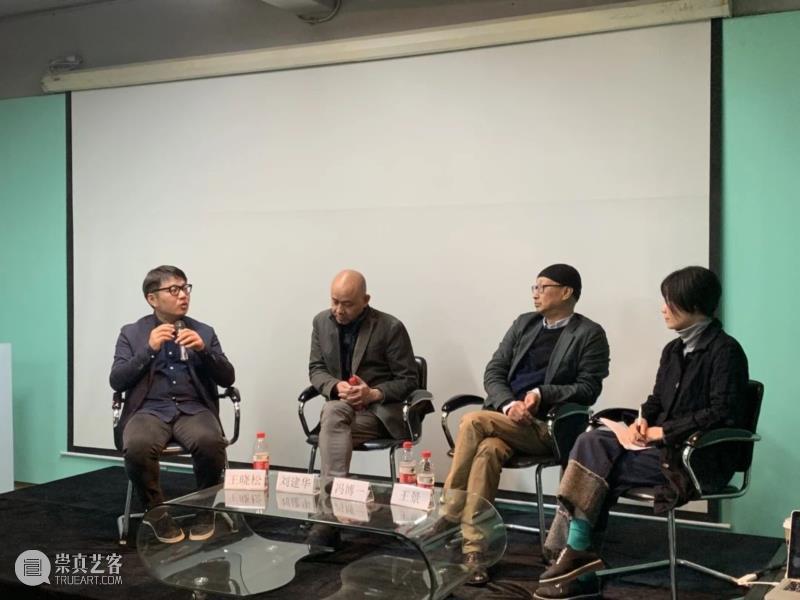
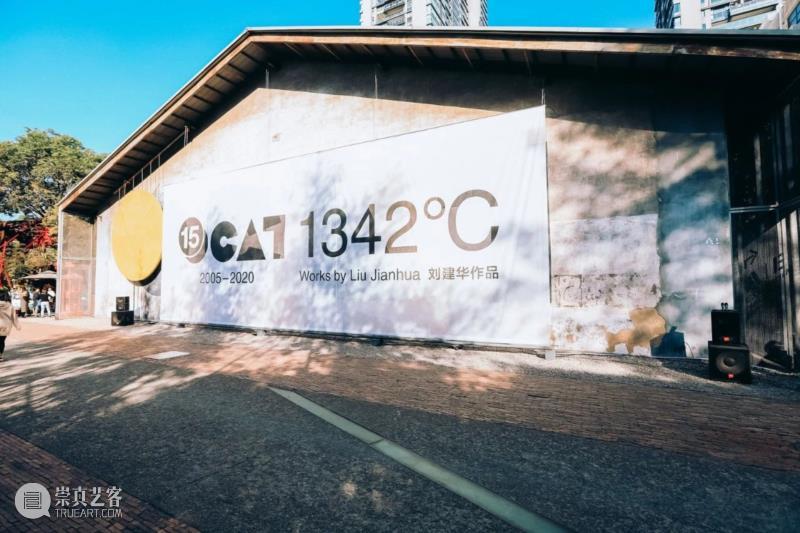
Superdry: The Art of Liu Jianhua
Feng Boyi
Translated by Mary Ann O’Donnell
1342ºC is the highest temperature when firing ceramics. The exhibition title, 1342ºC is part of the series of case study research that has been undertaken by the OCAT Shenzhen, indicating how Liu Jianhua is working within and against the limits of “porcelain” as a medium, as well as the unpredictability of materials and firing process. This also invokes Liu Jianhua’s years of ongoing artistic experimentation with the process and results of “melting points” and relating to his active “igniting point” within the context of contemporary Chinese art. Liu Jianhua’s solo exhibition comprises the technical means and methods of porcelain firing, specific forms, his use of media and visual language, the exhibition space, and display. It is an exploration of the intrinsic logic and multidimensional realization of the relationships between tradition and the present, as well as between material and visual cultures.
In Chinese traditional culture, the five elements are metal, wood, water, fire and earth, with "earth and fire" simultaneously constituting and symbolizing the material world. As specific manifestation of “earth and fire”, porcelain has always been closely related to Liu Jianhua’s experience of survival, growth and creation. Liu Jianhua's sensitivity to, awareness of, and mastery over porcelain derive from this understanding of porcelain as elemental matter. The current solo exhibition manifests the concepts and visual turn that have characterized Liu Jianhua's art in recent years. These works have long since escaped the exaggeration and irony of gaudy expression, and turned from his previous work in realism and sociological investigation. Although there seems no clear and realistic cultural orientation, nevertheless the traditionally shaped porcelain utensils, such as Container, Filled, Blank Paper, Rope, and The End of 2012. In particular, works such as Fallen Leaves, Rime, and Sand reveal how continuous experimentation with porcelain firing technologies transforms raw nature into true-to-life quotidian objects and primal objects, realistically and naturally combining simple, rustic details, as well as love of the material and the object’s essential charm. As far as the theme structure of the work is concerned, it is not a grand narrative, nor is it something outside our ordinary social life. It seems that form is casually bestowed, without leaving traces of cultural orientation, creating the illusion that the artist's work is inaction, so that all that remains is delight in the texture and transformation that is porcelain art and the surprises that are caused by hands that shape and reshape the clay. In fact, these works Liu Jianhua neither intentionally pursued the glazed appearance of artifacts, nor succumbed to personalized taste.
In terms of artistic expression, the inadvert is actually a force, giving people the feeling of returning to nature and being natural. Wang Xiaosong has said, “An important source of Liu Jianhua's art is the experience of everyday life. He uses the materials that everyone is familiar with to carry out the 'reincarnation' of ordinary things in life, creating a special 'meaningless' in a strange space (Wang Xiaosong, ed. (2019). Clinging to the Surface: Liu Jianhua, 2008-2018. Shanghai: Sanlian Bookstore, 64.)” In my opinion, replication and restructuration as means of effecting transformation has changed the function and essence of porcelain as a material and exceeded the unique product of traditional porcelain, becoming an identity that records traces of nature, time and memory. This process directly corresponds to and measures the vicissitudes of nature and ecology. At his Jingdezhen porcelain factory, for example, apprentices repeatedly beat clay into colorful forms that comprise Color. Perhaps this constitutes the visual simplicity, purity and extreme dryness of his work. The tangible items in Liu Jianhua's works are gradually changed by invisible things into intangible insight and unfolding. In other words, Liu Jianhua neither limited the unfolding of time and space to the level of record, nor was he satisfied by converting the medium into a simple visual image, instead he precipitated his attitudes and feelings about nature and life into the “object’s” background color, transcending the dust of time to discover and rethink how we know our situation. Therefore, he has realistically expressed the interiority of the real world, giving us an abstract expression of inner refraction.
To say that one has not deliberately sought the meaning of things and phenomena, is not to say that things and phenomena are meaningless. An art rooted in nature and the quotidian is first of all the ability to discover meaning in the most meaningless things, the ability to elevate anything that is casual and important everywhere. In Sand, Fallen Leaves and Rope, Liu Jianhua uses a process of reproduction that eliminates our usual understanding of and judgment on sculpture art concepts, or rather changes the attributes of the original object through porcelain media. This attempted simulation results in different textures in the original and copy, function as the handwriting of a manuscript. This is of course not a copy in the ordinary sense, but a transplant and misappropriation of the postmodernist approach. To be precise, Liu Jianhua uses his artistic transformations to display his thinking and cognition of tradition, uncertainty and multiple meanings of porcelain, and thus the disappearance of the sense of distance between artificial objects and natural objects. This sense of distances produces beauty in the aesthetic sense that postmodern artworks no longer hold value and meaning. It also points to the disappearance of the originality and uniqueness as the ultimate value and eliminating the value of judging authenticity. At the same time, if we acknowledge that Liu Jianhua's practice is postmodern, then the purpose of this method is to eliminate the explanatory oppositions between surface and interiority, real and and non-real, signified and signifier, such that the “depth” of value appears on the surface. The disappearance of depth is what allows traditional thinking about depth to be broken and flattened. Natural and daily subjects have been sublimated by the artist's choice and processing, but this kind of treatment does not impose meaning on the object, but instead reflects the relationships between the specific life situation of people and their objects. Perhaps the meaning or value is generated and obtained from this most inconspicuous, neutral, ultra-daily interval, just as the audience walks in and listens to the fragile sound of porcelain fragments of Discard. It also gives the viewer a relationship between the real and non-specific boundaries of nature, and in this separation seeks a new interpretation of people and objects as well as a way of enlightenment by way of transcending the ordinary.
This puts new demands on the current artistic creation. In the past, we paid too much attention to the pertinence of art and the symbolism of works. It was if the only communication possible between an artist, his work and its audience was via critique and revelation. In Liu Jianhua's works, he uses a low-material perspective to burn through the complex porcelain process to present the natural state of daily “materials” such as Bone and Blank Paper. From traditional cultural resources and his personal creative experience, he abstracts or cuts fragments express his concern for the humanistic ecology, as in Container and The End of 2012. In some cases, a preference for porcelain materials and visual language replaces the object itself as in Trace and Lines. This subversion and dismantling of the original material expression occurs through “mutual shaping.” I have always thought that in the field of contemporary art creation, sensitivity to contemporary society and culture would lead to changes in old ideas, and sensitivity to materials and media would lead to variations in the language and form of the works. Liu Jianhua's practice, on the one hand, provides a heterogeneous creative consciousness that re-recognizes our daily experience, allowing us to re-recognize the life comprised by our reality and nature. On the other hand, processing matter via its interior, destroying the control of material through its own energy, and thereby transforming inherited use trajectories reveals the limitations of accepted visual patterns, and deconstructs the single form of matter, making the standards provided by these familiar materials short and unreliable as well as providing a more intriguing perception at the intersection of the familiar and the strange. Liu Jianhua has said, “What I want to express is not a realistic scene, but rather via natural states and familiar phenomenon to help people think about the aspects of life, time and individual emotion. Everyone’s feeling when when seeing Fallen Leaves is simultaneously familiar and strange. It is familiar because we have seen fallen leaves before. It is strange because the method of display in a museum and in different spaces reminds people to go out and have new experiences (ibid, 250).”
If we look at the transformational form of Liu Jianhua's creation within and against the contemporary period, on the one hand, we see that is a rethinking of the projection of “reality” that characterized previous work, leading him to have a new understanding of the expressive complexity of artistic materials and resetting the relationship between art and reality. On the other hand, his work pays attention to the specificity of real life, causing a kind of natural material and characteristics of everyday life to emerge. This has only become possible in the context of China’s economic rise. The meaning of everyday life is emphasized so that a natural state which has been neglected and suppressed in the grandiose narrative of modernity becomes one of the main concerns of artistic expression, enriching the project with unusual value and meaning. This rediscovery of nature and daily life, as well as the writing of natural objects, highlights the trivial details of daily life and the value of consumption. The history of natural life and the writing of individual life are given increasing significance. This is not the development of the traditional “humanist” macroscopic “subject,” but rather is an expression of the individual's survival experience on the material form. This kind of experience is not a complete rebellion against reality, but a dialectical relationship with the natural world. Therefore, Liu Jianhua not only expresses a “materialized” complex, but also has a concrete measurable space, in the form of a non-politicized, universal fashion and custom, as well as personal development, instant gratification, and chasing change in which specific values are rationalized as free choices in individuals' daily lives. Therefore, although he does not directly express the complexity of reality, nevertheless this may actually make his creation. The reality of reclusiveness makes his art retain the fine details of the lingering truth, highlighting the texture and mystery of his visual language. We often encounter such fine subsections when viewing his works. Of course, this is also related to the new logic of capital that is shifting from the “materialization” of the real economy to the abstraction and virtual “materialization” of the “new economy” of the virtual economy. However, its essence reflects the “material” satisfaction and happiness of obtaining a broad concept, which is precisely the loss of the sense of security of natural existence, as well as the feelings of emptiness such as anxiety and entanglement, as the ruins set in his Discard. Therefore, the works of Liu Jianhua’s exhibition have upset many of the grand imaginaries about artistic creation, and formed the basic attitude and standpoint of his artistic creation in the context of purer or “superdry” context.
Of course, this is my interpretation of the relationship between the understanding of low-substance concepts and the actual logic in Liu Jianhua's new work. Or perhaps it is the elevation of and rumination on the banality of ordinary substrates—a rediscovery of everyday life. Therefore, Liu Jianhua’s art practice is not to continuously enhance and enrich the language and style of sculptures and installations, but rather to continuously think through boundary issues such as artistic expression, media, and visual language in traditional porcelain art and even the contemporary art scene. The hope is achieve mutual impact between traditional cultural resources and expressive and aesthetic taste, and even anticipating influence on future artistic creation. Wu Hung has explained, “The essential significance of Liu Jianhua's artistic exploration lies in his extension of the contact point between contemporary art and traditional Chinese culture—or activation point—to the visual and material culture outside the narrow sense of art. The field has introduced theoretical issues with respect to technique, materiality, and visuality, and can even lead to rethinking the definition of contemporary art (Wu Hung, “How to Contemporarize Porcelain - Thoughts Inspired by Liu Jianhua’s Artistic Explorations.” ibid, 2).” Therefore, Liu Jianhua’s experimental art, which arrises both within and outside tradition is not only the aesthetic or language perfection of a certain traditional category and style, but also a breakthrough effect achieved through constant experiment, challenge and subversiveness. It even constitutes a visual sample of his personal or Chinese experience in the contemporary art system. Just like he intentionally left the page blank in Blank Paper.
---
正 在 展 出
The Scene of the Exhibition
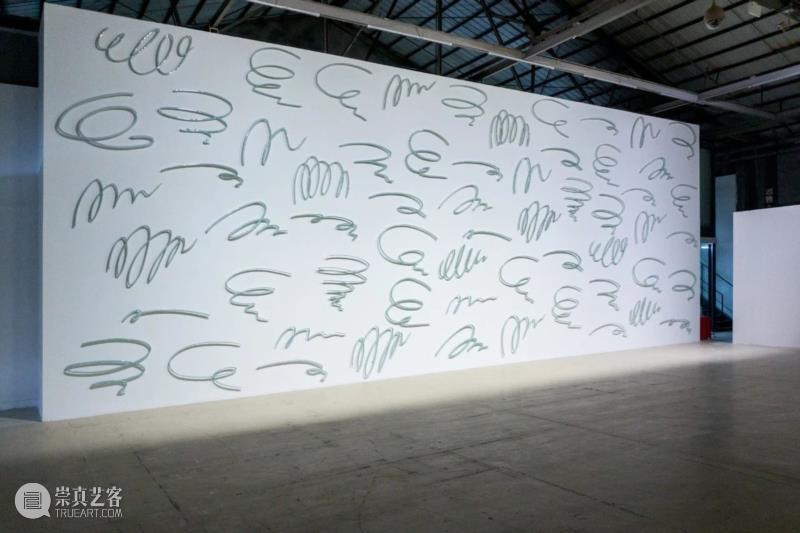
线条 Lines
瓷 Porcelain
可变尺寸 Variable dimensions
2015-2019

沙 Sand
陶瓷、耐火材料 Porcelain、Fire-proof material
可变尺寸 Variable dimensions
2012-2019

颜色 Color
瓷 Porcelain
可变尺寸 Variable dimensions
2016-2019

落叶 Fallen Leaves
瓷 Porcelain
可变尺寸 Variable dimensions
2011-2013

雾凇 Rime
瓷 Porcelain
197.5 x 10 x 12 cms
2012-2015

迹象 Trace
瓷 Porcelain
可变尺寸 Variable dimensions
2011

白纸 Blank Paper
瓷 Porcelain
200 x 120 x 0.7 cms
2008-2019


遗弃 Discard
瓷 Porcelain
可变尺寸 Variable dimensions
2001-2011

“艺术家个案研究”
“OCAT15周年”系列项目
Contemporary Artists Case Study Research
"OCAT 15th Anniversary" Series
1342ºC: Works by Liu Jianhua
1342ºC——刘建华作品
展览总监:栾倩、毕大松
策展人:冯博一、王景
Exhibition Directors:Luan Qian、Bi Dasong
Curators:Feng Boyi、Wang Jing
2019.12.8 - 2020.4.7
OCAT深圳馆_展厅A\B
OCAT Shenzhen
Exhibition Halls A and B
---

「 开幕图片直播 」

「 导览直播回放 」

「 导览直播回放 」
☞ [ 开幕回顾 ]
☞ [ 新展预告 ]
---
关 于 艺 术 家
About the Artist
刘建华
1962年出生于中国江西,1989年毕业于江西景德镇陶瓷学院(现景德镇陶瓷大学)美术系雕塑专业,1989年至2004年在昆明云南艺术学院美术学院雕塑系任教;2004年起至今在上海大学美术学院雕塑系任教,现生活、工作于中国上海。
刘建华以综合材料为主要媒介,是中国当代艺术领域最具实验性、代表性的艺术家之一。1989年大学毕业后,他尝试在当代背景下进行实验性的创作。刘建华的陶瓷和综合材料作品反映了近年来不断困扰中国的经济和社会变化。他的《日常·易碎》系列于2003年威尼斯双年展中国馆中首次展出,刘建华将日常用品复制成外表和象征意义大于实用性的神秘物体。2008年,他一反先前多年对全球化及中国社会急剧转型引发的诸多问题、焦点的近距离直接关注,提出“无意义、无内容”的理念来进行创作,从2008年作品《无题》开始了一个全新方向的探索,并形成了当代艺术创作的个人语言体系。
刘建华作品受邀参加2019年洛杉矶郡立艺术博物馆巡展、2018年意大利那不勒斯Made in Cloister基金会个展、新加坡国家美术馆极简主义主题展、2017年第57届威尼斯双年展主题展、日本第六届越后妻有大地艺术祭三年展、第一届基辅当代艺术双年展、意大利第十四届卡拉拉国际雕塑双年展、第十七届悉尼双年展、加拿大2009年温哥华双年展、第三届南京三年展、第二届莫斯科双年展、第一届新加坡双年展、第六届上海双年展、2006 釜山双年展、第50届威尼斯双年展中国馆等展览,以及由英国泰特现代美术馆、法国蓬皮杜艺术中心、旧金山亚洲艺术博物馆、丹麦奥胡斯美术馆、日本东京森美术馆、英国泰特利物浦美术馆、北京尤伦斯当代艺术中心、上海当代艺术博物馆、瑞士伯尔尼艺术博物馆、香港艺术中心、北京今日美术馆、上海美术馆、上海当代艺术馆、深圳华美术馆、德国德累斯顿国家艺术收藏馆、深圳美术馆、广东美术馆、北京中国美术馆、荷兰格罗宁根艺术博物馆、奥地利维也纳路德维希当代美术馆、荷兰眼镜蛇当代艺术美术馆、奥地利埃舍尔收藏博物馆、德国汉堡当代美术馆、都柏林爱尔兰现代美术馆、法国马赛现代艺术博物馆等机构举办的展览。
刘建华作品还被美国纽约现代艺术博物馆(MOMA)、英国伦敦泰特现代美术馆、英国伦敦维多利亚与阿尔伯特美术馆(V&A)、美国旧金山亚洲艺术博物馆、美国南加州大学亚太博物馆、澳大利亚悉尼白兔艺术中心、迪奥巴黎总部、路威酩轩艺术基金会、意大利佛罗伦萨萨尔瓦多·菲拉格慕博物馆、K11艺术基金会、挪威俾尔根KODE美术馆、香港M+美术馆、上海余德耀美术馆、上海浦江华侨城、日本十和田市美术馆、纽约古根海姆美术馆、澳大利亚悉尼新南威尔士艺术博物馆、中国上海世博会组委会、中国上海陆家嘴环球金融中心、西班牙国家银行艺术中心、北京今日美术馆、深圳美术馆、广东美术馆、澳大利亚昆士兰美术馆、日本原美术馆、中国香港中国会、深圳何香凝美术馆等公共机构和私人收藏。
---
关 于 策 展 人
About the Curators
冯博一
独立策展人、美术评论家。现生活工作于北京。
从上世纪80年代末开始,致力于中国当代艺术的策划、评论、编辑等工作,注重当代艺术的实验性、批判性,关注于边缘、另类的艺术群体和年轻一代的生存状态和艺术创作。撰写有几十万字的论文、评论文章。
策划的重要展览有:“生存痕迹——98中国当代艺术内部观摩展”(北京)、“不合作方式”1、2展(上海、荷兰格罗宁根美术馆)、“重新解读——首届广州当代艺术三年展”(广东美术馆)、“左手与右手——中、德当代艺术展”(北京798艺术区)、“今日中国——中国当代艺术的转世魅影”展(奥地利维也纳埃索美术馆、荷兰COBRA美术馆)、“成都双年展”(成都会展中心)、“七零八落”艺术展(北京798艺术区帝门画廊)、“杂七杂八”艺术展(苏州金鸡湖美术馆)、“透视的景观——第六届深圳国际当代雕塑艺术展”(深圳OCT艺术中心)、“移花接木——中国当代艺术的后现代方式”展(华美术馆)、“我的骨肉皮”(纽约亚洲艺术艺术博览会主题展)、“地图游戏:变化动力——国际视觉艺术暨建筑项目”(北京今日美术馆、英国伯明翰博物馆、意大利Terni国际当代艺术中心)、五届“两岸四地艺术交流计划”(何香凝美术馆、台北市立美术馆、香港奥沙艺术空间、澳门艺术博物馆)、“一种生存实在属性的叙事——中国当代艺术展”(挪威俾尔根美术馆)、“首届CAFAM未来展:亚现象——中国青年艺术生态报告”(北京中央美术学院美术馆)、“世代转化的中国创造当代艺术展”(丹麦奥胡斯美术馆)、“乌托邦·异托邦——乌镇国际当代艺术邀请展”等。是为中国目前最活跃的独立策展人和评论家之一。
王景
生于1982年、广东。毕业于广州美术学院美术史系和纽约巴德学院策展研究中心。目前生活工作于深圳,任职于OCAT深圳馆研究部。
她(参与)策划的展览包括:“许志强:瓷砖空间”(招引空间,深圳,2019);“不被察觉”影像展(招引空间,深圳,2018);“大环境——陈侗、田挥双个展”(盒子空间,深圳,2018);“(生成)洁净”(牛棚艺术村,香港,2017);“一次集结:缅怀与重构——2016年上海浦江华侨城十年公共艺术计划”(OCAT上海浦江展区,2016);“12点(13小时时差)”(海塞尔美术馆,纽约,2015);“补充说明”(海塞尔美术馆,纽约,2014);“次要的东西”(海塞尔美术馆,纽约,2013);“去——OCAT青年计划首展”(OCT当代艺术中心,深圳,2010);“出境——广深港澳当代艺术展”(何香凝美术馆,深圳,2008);“醒着的,睡着的”——丹尼尔·克诺个展(非艺术中心,上海、博尔赫斯书店当代艺术机构,广州、E6空间,深圳、业社空间,武汉,2008);“这是我的风景——艾伦·茨威格录像展”(非艺术中心,上海、博尔赫斯书店当代艺术中心,广州,2008);“你的身体是我的战场——当代行为展”(非艺术中心,上海,2007)。
她参与OCAT、维他命艺术空间、旧金山中华文化中心等机构的出版物编辑工作。出版包括《当代已然成史:我(们)与黄专》(岭南出版社,2016-2018);《现在时双年展2015》(旧金山中华文化中心,2015);“OCAT图书馆系列出版物”之《亚历山大·科耶夫作为智者:鲍里斯·格罗伊斯讲座》、《拉希德·阿拉因在深圳:拉希德·阿拉因讲座》、《克里斯·马克电影中的历史和记忆:郝敬班讲座》(OCT当代艺术中心,2012-2013);《语词、意识与艺术——徐坦“关键词”视觉语言实验项目档案》(岭南出版社,2011);《徐坦:“科云”的词》(维他命艺术空间,2011);《国家遗产:一项关于视觉政治史的研究》(RIGHTON PRESS,2009);《张培力:艺术工作手册》(岭南出版社,2008)。
她的写作和采访发表于艺术论坛中文网站、《画廊》杂志、《Bomb》杂志、《世界建筑导报》、《外滩画报》等。


OCAT深圳馆成立于2005年,位于华侨城创意文化园内,是OCAT馆群的总馆。作为馆群中成立最早的机构,OCAT深圳馆长期致力于国内和国际当代艺术和理论的实践和研究。从开创至今,一直围绕着艺术的创作和思考而展开其策展、研究和收藏工作。
地址:深圳南山区华侨城恩平街华侨城创意文化园南区F2栋OCAT深圳馆
开放时间:10:00 - 17:30(逢周一闭馆)
网站:http://www.ocat.org.cn/index.php/home
微信公众号:OCAT深圳馆(ID: OCATShenzhen)
微博:OCAT深圳馆
Instagram:ocatshenzhen
Facebook:OCT Contemporary Art Terminal - OCAT Shenzhen
__________
长按二维码,走进OCAT深圳馆


已展示全部
更多功能等你开启...





 分享
分享